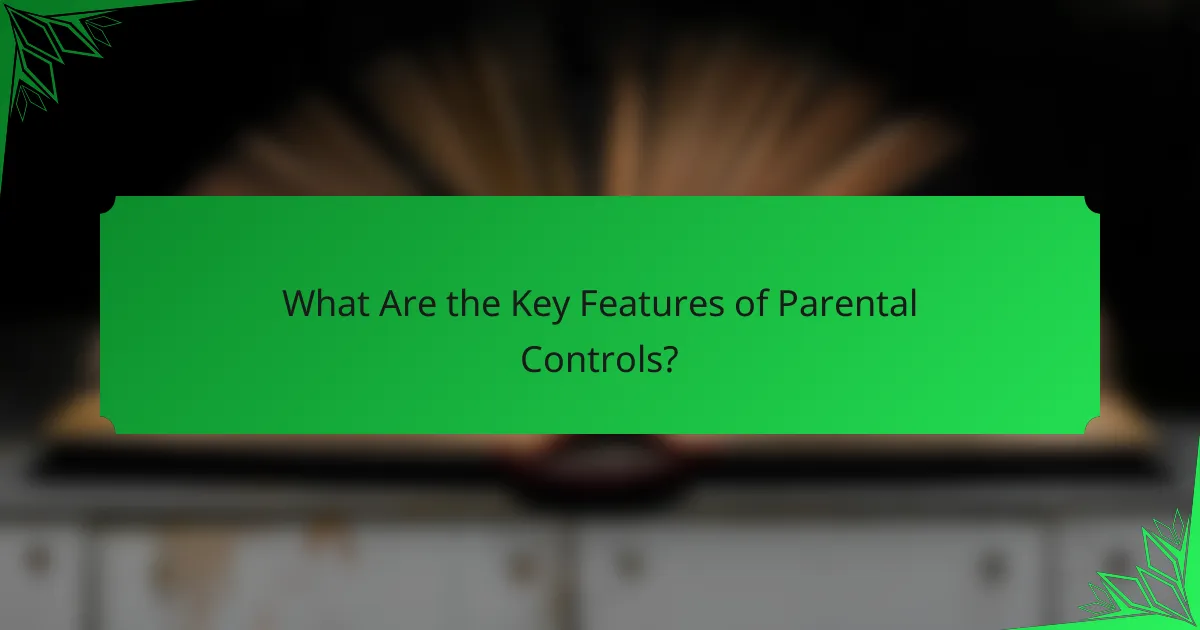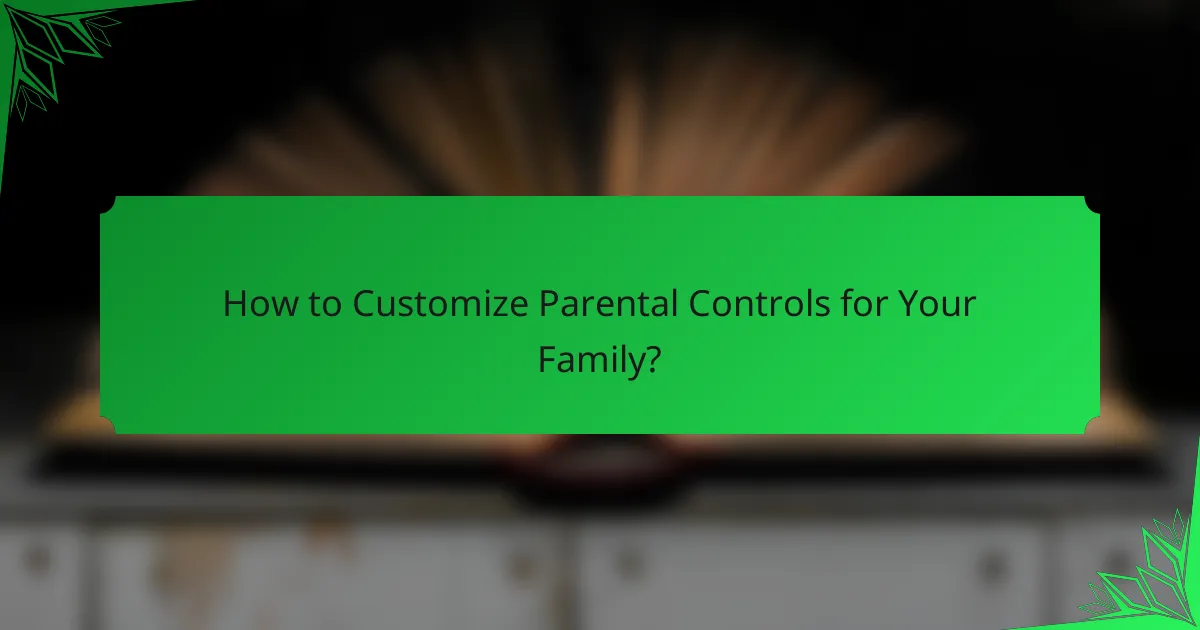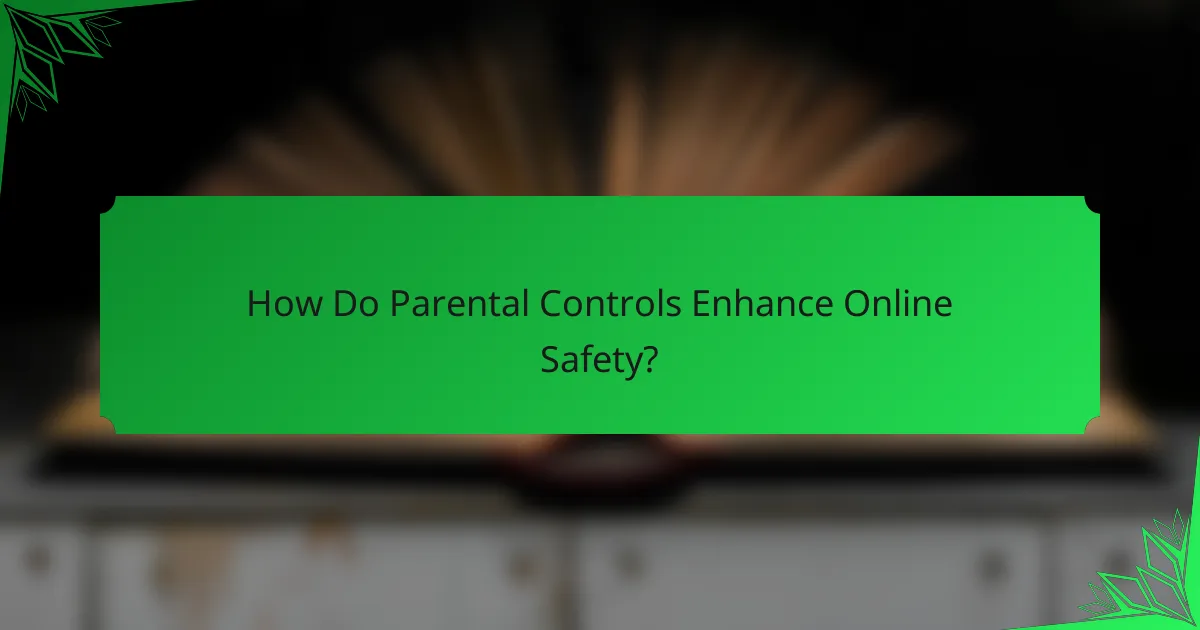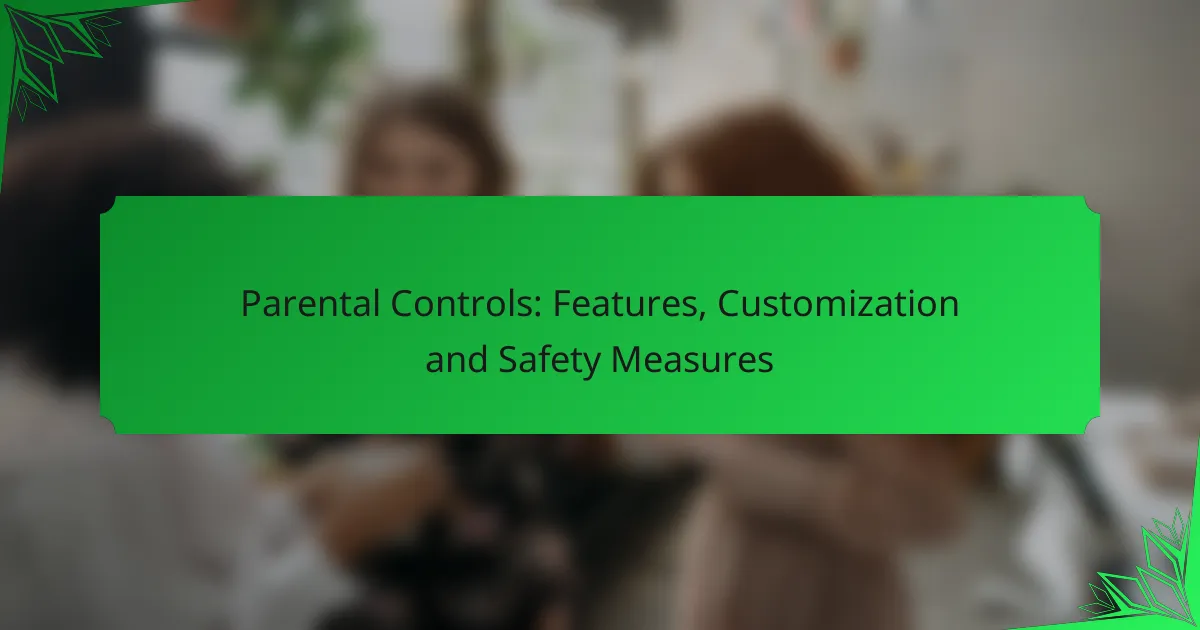Parental controls are essential tools designed to help parents oversee their children’s online activities and create a safer digital space. With features like content filtering, time management, and activity monitoring, these tools can be customized to fit your family’s specific needs and values, ensuring a secure online experience for children.

What Are the Key Features of Parental Controls?
Parental controls are tools that help parents manage their children’s online activities and ensure a safer digital environment. Key features typically include content filtering, time management, activity monitoring, device restrictions, and location tracking.
Content filtering
Content filtering allows parents to restrict access to inappropriate websites and applications based on age-appropriate criteria. This feature can block explicit content, social media, or gaming sites that may not be suitable for children.
Many parental control systems offer customizable filtering options, enabling parents to create a tailored experience. For example, they can set categories of content to block or allow specific websites while monitoring attempts to access restricted sites.
Time management
Time management features help parents regulate how long their children can spend on devices or specific applications. This can include setting daily limits or scheduling device-free times, such as during homework or bedtime.
Parents should consider using time management tools to promote healthy screen time habits. For instance, setting a limit of one to two hours of recreational screen time per day can encourage children to engage in other activities.
Activity monitoring
Activity monitoring provides insights into a child’s online behavior, including the websites they visit and the applications they use. This feature can help parents identify potential risks or problematic behaviors early on.
Many systems offer reports that summarize activity over time, allowing parents to have informed discussions with their children about their online choices. Regularly reviewing this information can help parents stay engaged in their child’s digital life.
Device restrictions
Device restrictions enable parents to control which devices their children can use and when. This can include blocking access to certain devices during specific hours or limiting the types of devices that can connect to the home network.
Implementing device restrictions can help create a balanced environment where children are encouraged to engage in offline activities. For example, parents might restrict gaming consoles during school nights to promote better focus on studies.
Location tracking
Location tracking features allow parents to monitor their child’s whereabouts through GPS technology. This can provide peace of mind, especially for parents of younger children or teens who are often out with friends.
Parents should ensure they discuss the use of location tracking with their children to foster trust. Setting up geofencing alerts, which notify parents when a child enters or leaves a designated area, can be an effective way to enhance safety without being intrusive.

How to Customize Parental Controls for Your Family?
Customizing parental controls involves setting specific features that align with your family’s needs and values. This can include user profiles, content filters, and access schedules to ensure a safe online environment for children.
Setting user profiles
Creating user profiles allows you to tailor the online experience for each child based on their age and maturity level. Most devices and platforms enable you to set up individual accounts, which can help in managing access to certain content and features.
When setting up profiles, consider the age-appropriate restrictions for each child. For instance, younger children may need stricter controls, while teenagers might require more freedom to explore. Regularly review and adjust these profiles as your children grow and their needs change.
Adjusting content filters
Content filters help block inappropriate websites and applications, ensuring a safer browsing experience. Most parental control tools offer customizable settings that allow you to filter content based on categories such as violence, adult content, or social media.
To effectively adjust content filters, familiarize yourself with the available categories and set them according to your family’s values. For example, you might choose to block social media for younger children while allowing it for older teens. Regularly update these filters to adapt to new content and trends.
Scheduling access times
Scheduling access times helps manage when children can use devices, promoting a healthy balance between screen time and other activities. Most parental control systems allow you to set specific hours for device usage, which can be particularly useful during homework time or bedtime.
When creating a schedule, consider your family’s routine and the importance of offline activities. For instance, you might allow device access after school but restrict it during family meals or late at night. Regularly review and adjust these schedules to accommodate changes in your family’s lifestyle or school commitments.

What Are the Best Parental Control Tools Available?
The best parental control tools provide comprehensive features to help parents manage their children’s online activities. These tools typically include web filtering, screen time management, and activity monitoring to ensure a safer digital environment.
Norton Family
Norton Family offers a robust suite of parental controls designed to protect children online. It allows parents to monitor web activity, set time limits, and block inappropriate content across multiple devices.
One key feature is the ability to receive alerts about your child’s online behavior, which helps in addressing potential risks promptly. Norton Family is compatible with Windows, Android, and iOS, making it versatile for family use.
Qustodio
Qustodio is known for its user-friendly interface and powerful monitoring capabilities. It provides detailed reports on online activity, including social media usage, and allows parents to set daily screen time limits.
This tool supports various platforms, including Windows, Mac, Android, and iOS. Qustodio also features a panic button for children, which can send alerts to parents in case of emergencies.
Net Nanny
Net Nanny is a popular choice for its real-time internet filtering and monitoring features. It can block harmful content and send alerts to parents when children attempt to access restricted sites.
Additionally, Net Nanny offers a unique feature that allows parents to monitor social media activity, providing insights into their child’s online interactions. It works on multiple devices, including Windows, Mac, Android, and iOS.
Circle Home Plus
Circle Home Plus is a device that connects to your home Wi-Fi network, allowing parents to manage all connected devices from one app. It offers features such as internet pause, bedtime settings, and usage tracking.
This tool is particularly useful for families with multiple devices, as it provides a centralized way to enforce parental controls. Circle Home Plus is compatible with any device connected to your home network, making it a flexible option for managing screen time and online safety.

How Do Parental Controls Enhance Online Safety?
Parental controls significantly improve online safety by allowing parents to manage and restrict their children’s internet usage. These tools help protect kids from inappropriate content, monitor their interactions, and limit the time they spend online.
Preventing exposure to harmful content
Parental controls can block access to websites and apps that contain inappropriate or harmful material. By setting filters based on age ratings or specific keywords, parents can create a safer online environment for their children.
Consider using content filtering tools that categorize websites into safe and unsafe groups. Regularly review and update these settings to adapt to your child’s changing needs and interests.
Monitoring online interactions
Monitoring tools allow parents to keep track of their children’s online interactions, including messages and social media activity. This oversight helps identify potential risks, such as cyberbullying or inappropriate conversations.
Choose monitoring solutions that provide alerts for suspicious activities. Discuss with your child the importance of transparency in online interactions to foster trust and open communication.
Limiting screen time
Limiting screen time is crucial for maintaining a healthy balance between online and offline activities. Parental controls can set daily or weekly usage limits, ensuring children do not spend excessive time on devices.
Establish clear rules about screen time, such as no devices during meals or before bedtime. Encourage alternative activities, like outdoor play or reading, to promote a well-rounded lifestyle.
